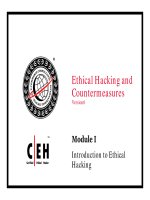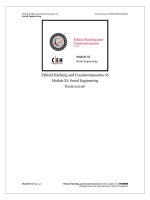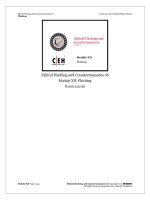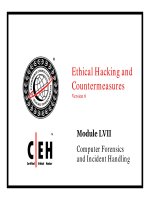Ethical hacking and countermeasures - phần 31 pdf
Bạn đang xem bản rút gọn của tài liệu. Xem và tải ngay bản đầy đủ của tài liệu tại đây (238.96 KB, 40 trang )
Ethical Hacking
Windows Based Buffer
Overflow Exploit Writing
EC-Council
Copyright © by EC-Council
All Rights reserved. Reproduction is strictly prohibited
Buffer Overflow
Computer programs usually allocate certain
amount of space to store data during execution.
This space is known as buffer
A buffer overflow occurs when the amount of
data is larger than the allocated buffer
When that happened, the data will overwrite
memory area that followed the buffer
EC-Council
Copyright © by EC-Council
All Rights reserved. Reproduction is strictly prohibited
Stack overflow
Function calls in C program usually pass
parameter via stack
A caller program will store parameters into
stack before calling a function
The function will then locate the parameters
from the stack
Stack also will contain return address so that
the function can jump back to the caller
program
If we can submit data more than previously
allocated space, we can overflow the dedicated
space and if we can overwrite the stack
EC-Council
Copyright © by EC-Council
All Rights reserved. Reproduction is strictly prohibited
Writing Windows Based Exploits
What you will need?
• Windbg.exe
• Borland TASM
• Hex Editor
• Visual Studio C Compiler
• Windows 2000 Server
• SQL Server 2000 (To Exploit the vulnerability)
EC-Council
Copyright © by EC-Council
All Rights reserved. Reproduction is strictly prohibited
Exploiting stack based buffer overflow
Mark Litchfield published a buffer overflow in
OpenDataSource() with Jet database engine in
SQL Server 2000
We are going to exploit this vulnerability
EC-Council
Copyright © by EC-Council
All Rights reserved. Reproduction is strictly prohibited
OpenDataSource Buffer Overflow
Vulnerability Details
Microsoft's database server SQL Server 2000
has a remotely exploitable buffer overrun
vulnerability in the OpenDataSource function
when combined with the MS Jet Engine
By making a specially crafted SQL query using
the OpenDataSource function it is possible to
overflow a buffer in the SQL Server process,
gaining control of its execution remotely
EC-Council
Copyright © by EC-Council
All Rights reserved. Reproduction is strictly prohibited
Simple Proof of Concept
This Transact SQL Script will create a file called "SQL-
ODSJET-BO"
on the root of the C: drive on Windows
2000 SP 2 machines
This code demonstrates how to exploit a UNICODE
overflow using T-SQL Calls CreateFile() creating a file
called c:\SQL-ODSJET-BO
The return address is overwritten with 0x42B0C9DC
This is in sqlsort.dll and is consistent between SQL
2000 SP1 and SP2
The address holds a jmp esp instruction
EC-Council
Copyright © by EC-Council
All Rights reserved. Reproduction is strictly prohibited
The Code
EC-Council
Copyright © by EC-Council
All Rights reserved. Reproduction is strictly prohibited
Code Continued
EC-Council
Copyright © by EC-Council
All Rights reserved. Reproduction is strictly prohibited
Windbg.exe
Launch WinDbg.exe and attach sqlservr.exe process
You will need to debug SQL Server by pressing (F5)
process in Windbg.exe
Open up your Query Analyzer and try executing this
query about 300 A’s
EC-Council
Copyright © by EC-Council
All Rights reserved. Reproduction is strictly prohibited
Analysis
The query should overflow the SourceDB
parameter, and it will overwrite several CPU
registers as well as the ever important EIP
Before Query Analyzer can return any result,
the WinDbg will intercept
The instruction should point at 0x41414141,
which is an invalid address
Take a look at register EIP, it is 0x41414141
We have overwritten EIP with the ASCII code of
‘A’ (0x41)
EC-Council
Copyright © by EC-Council
All Rights reserved. Reproduction is strictly prohibited
EIP Register
EIP is the that register determines the next
instruction that the CPU will execute
Being able to write to EIP means we can control
the execution flow of the program
Somewhere in the 300 A’s will overwrite the
EIP register
We need to find the exact location so that we
can inject useful address to EIP
EC-Council
Copyright © by EC-Council
All Rights reserved. Reproduction is strictly prohibited
Location of EIP
To get the exact location of the EIP, we can
construct a query like the following:
You may need to terminate your SQL server,
attach to process again using WinDbg
Run Query Analyzer and connect to your SQL
server again
EC-Council
Copyright © by EC-Council
All Rights reserved. Reproduction is strictly prohibited
EIP
This time, your EIP will be 0x47484848. This is
equivalent to GHHH
We need to replace GHHH with a useful memory
address, may be memory address that point to our
payload
The payload will execute anything we want
It also tells us that we need to put our memory address
in reverse byte sequence
Let’s construct a query that just enough for us to
overwrite EIP
It will take 269 A’s for padding and 4 more bytes that
will overwrite the EIP
EC-Council
Copyright © by EC-Council
All Rights reserved. Reproduction is strictly prohibited
Execution Flow
Take a look at WinDbg
Access Violation is trying to execute code from 0x42424242
ASCII code of B is equivalent to 0x42, which is the last part of the
SourceDB string
The process flow to 0x42424242 because ‘BBBB’ have overwritten the EIP
register
By replacing BBBB with a memory address, the process will flow into that
memory address
In other word, we can jump to anywhere we want
EC-Council
Copyright © by EC-Council
All Rights reserved. Reproduction is strictly prohibited
But where can we jump to?
We are going to jump to our payload. Our
payload will execute something useful like
spawning a shell for us, creating a file and so on
It is possible to jump directly to our payload if
we know the address of our payload
To do that, we just need to replace BBBB with
our address
But usually, the address of our payload may not
be in a fix location/address all the time
EC-Council
Copyright © by EC-Council
All Rights reserved. Reproduction is strictly prohibited
Offset Address
If we can find a register
that point to our buffer or
query in this case
We can then jump to the
address store in the
register to get to our
buffer
This method is preferred
because we can jump to
our code/buffer no matter
where it is
Let’s find the register
Take a look at what each
register hold during the
crash:
EDI=0
ESI=EB2288
EBX=FFFFFFFF
EDX=301FCB10
ECX=301FCAC0
EAX=AB
EBP=41414141
EIP=42424242
ESP=301FCC50
EC-Council
Copyright © by EC-Council
All Rights reserved. Reproduction is strictly prohibited
We need to find a register that is related to our buffer
If you type the value of EDX to the Memory window
inside WinDbg, you will see that it points to a location
above the long e:\AAAA…AAAA buffer
If we want to jump to EDX, we must be able to put our
payload before the e:\AAAA buffer, which is not
possible
Let’s take a look at ESP
• It points to memory location just after the BBBB. This is perfect
• If we jump to the value hold by ESP, we will jump back to our
buffer
• We will land on the byte immediately after the value we
overwrite EIP
EC-Council
Copyright © by EC-Council
All Rights reserved. Reproduction is strictly prohibited
The Query
The structure of our query should look like this:
• SELECT * FROM OpenDataSource(
'MSDASQL','Driver=Microsoft Visual FoxPro
Driver;SourceDB=
e:\A…A<EIP><payload>;SourceTyp
e=DBC') xactions;
Now that we have found a perfect location for our
payload, all we need to do is to jump to that location
In order to do that, we need to execute something like
“jmp esp”
We can overwrite the EIP to point to somewhere in the
memory that contain instruction “jmp esp”
When the CPU reaches memory address that contains
the instruction, it will jump back to our payload because
ESP point to our payload
EC-Council
Copyright © by EC-Council
All Rights reserved. Reproduction is strictly prohibited
Finding jmp esp
We need to overwrite EIP with an address that
contain instruction “jmp esp”
First, let’s find out what this instruction is, in
machine code or opcode
Use debug.exe and type assembly code “jmp
esp” and dump the memory to see the actual
machine code of the instructions
EC-Council
Copyright © by EC-Council
All Rights reserved. Reproduction is strictly prohibited
Debug.exe
The machine code for “jmp esp” is “FF E4”
EC-Council
Copyright © by EC-Council
All Rights reserved. Reproduction is strictly prohibited
listdlls.exe
This program lists all the DLLs that are currently loaded, including
where they are loaded and their version number
Output from listdlls.exe will show many loaded DLLs and their
base memory
We can use any one of it
Take note that base memory of system DLL may be different in
different OS and Service Pack
Thus, if we are using offset from DLL, our exploit code will bind to
specific OS and service pack
In this case, we will browse through msvcrt.dll to look for FF E4
• C:\>findhex msvcrt.dll FF E4
• Opcode found at 0x78024e02
• End of msvcrt.dll Memory Reached
EC-Council
Copyright © by EC-Council
All Rights reserved. Reproduction is strictly prohibited
Msvcrt.dll
We will overwrite EIP with thmsvcrt.dll
address, and “jmp esp” will execute. It will jump
back to our buffer after EIP
The very first instruction that we will put into
our payload is the
“INT 3”
INT 3 (breakpoint) is a special instruction that
will course a debugger to suspend the program
for debugging
The hex code for this instruction is 0xCC
EC-Council
Copyright © by EC-Council
All Rights reserved. Reproduction is strictly prohibited
EC-Council
Copyright © by EC-Council
All Rights reserved. Reproduction is strictly prohibited
Out.sql
Compile the program and run it to generate out.sql
This is the file we will open in Query Analyzer
To test this, you must start WinDbg.exe and attach SQL
Server process as we did earlier
When you run out.sql in Query Analyzer, the WinDbg
will break but this time, instead of instruction pointing
to invalid address, you should see our instruction INT 3
(0xCC)
It is our breakpoint that suspends the SQL Server
We have the ability to execute any code now









